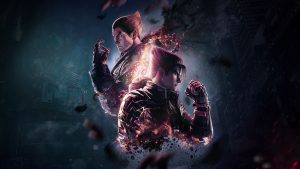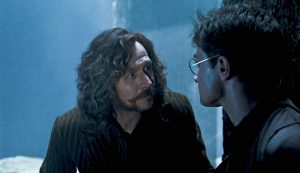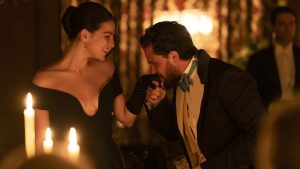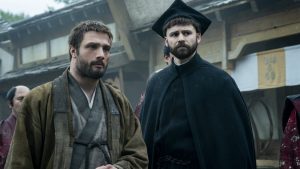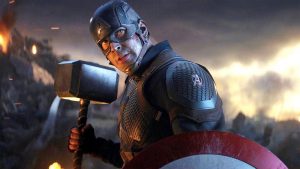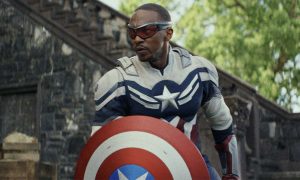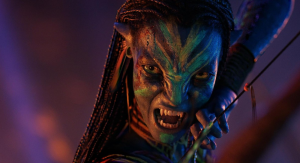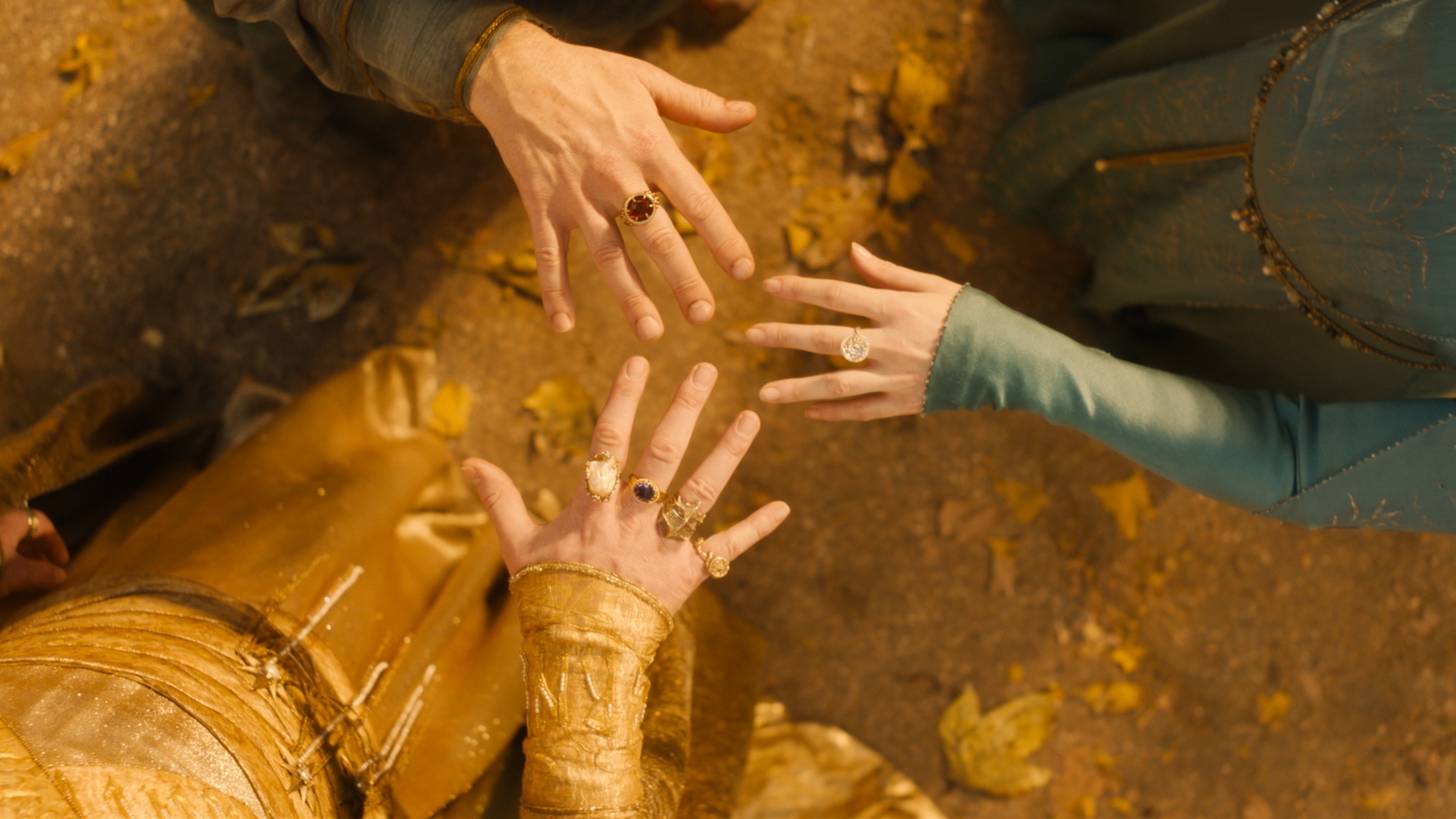
When you’re making a TV show called The Rings of Power, there’s a lot of pressure on whoever has to make and design the actual titular rings. The team working on season two of Amazon Prime’s Lord of the Rings series had another challenge as well. Season one was shot in New Zealand, but production shifted to the UK for season two, and as a result, many of the crew behind the scenes only just joined the project this season, including production designer Kristian Milsted, supervising art director Martin Foley, and set decorator Tina Jones, taking over from season one’s Ramsey Avery, Jules Cook, and Megan Vertelle, respectively.
This means that the various Rings of Power in the show will be designed and made by different people in the real world, but they still need to look like they have been made by the same two characters onscreen; Elven smith Celebrimbor (Charles Edwards) and the villainous Sauron (Charlie Vickers). When we paid a visit to the set of season two last year, the team were sworn to secrecy on exactly how many rings we will be seeing this season, but if we had to speculate, we would say we’ll probably see 16 new Rings of Power—all of the remaining major Rings of Power from Tolkien’s mythology except Sauron’s One Ring.
Here is our thinking on that one. The show has flipped the order in which J.R.R. Tolkien’s titular powerful rings were made. In Tolkien’s books, Sauron and Celebrimbor together made the 16 rings that were given to Dwarves and Men, then Celebrimbor made the Three Elven Rings by himself, then Sauron forged the One Ring by himself. In the show, the three Elven Rings were made first, with Celebrimbor forging them the end of season one, using some advice from Sauron in his show-only disguise of Halbrand. The season two trailer revealed that we will soon be seeing another of Sauron’s aliases, the beautiful Annatar, Lord of Gifts, and presumably he and Celebrimbor will be busy forging even more Rings of Power.
We expect that the only one we won’t see forged just yet is the One Ring. On the page, Sauron forged the One Ring by himself after breaking with Celebrimbor. He made it in the fires of Mount Doom in Mordor, which in season two is still under the control of Adar and his Orcs. Our guess is that the other Rings and Adar will first have be taken care of before Sauron can assume ultimate control of Mordor.
During our set visit, it was revealed that, although the stand that displays the Elven Rings and Celebrimbor’s forge have been redesigned to look a bit more impressive, the design of the Three Elven Rings themselves is already set. In fact, we have already seen the Elven Rings in the trailer: Nenya, the White Ring or Ring of Water, which is made of mithril and set with adamant and worn by Galadriel (Morfydd Clark); Vilya, the Blue Ring, set with a sapphire and worn by the Elven king Gil-galad (Benjamin Walker); and Narya, the Ring of Fire, set with a ruby and worn by Círdan the Elven shipwright, who is a new character for season 2, played by Ben Daniels.
The other advantage the team have in keeping some consistency of design is, of course, the involvement of fan favorite Tolkien artist and illustrator John Howe, who also worked on the Peter Jackson movies (along with Alan Lee) in the early noughties. The team used a combination of Howe’s designs, as well as researching historical rings. Foley tells us, “One of my team went out to different museums, [including] the British Museum, [to] photograph existing beautiful rings.”
Although Tolkien’s story is fiction, that historical research will help to make the rings feel like they belong in his created world. The mythologies that inspired Tolkien the most were Greek and Norse myths. The Ancient Greek philosopher Plato told the story of the Ring of Gyges in his treatise The Republic, a philosophical dialogue about the ideal city-state. The story is about an ancestor of the Lydian king Gyges who took a golden ring from a tomb and found it made him invisible. In Plato’s dialogue, a man called Glaucon suggests that no one would behave in a just way if they were wearing the ring, because there would be no social consequences to their behavior, but Socrates replies that only a man who chose not to abuse the ring’s power would be happy, as anyone who took advantage would be enslaved to its appetites.
Tolkien’s favorite mythological stories, though, were Norse, and there are a few magic rings in those myths too. The god Odin owned a gold ring called Draupnir, for example, which magically birthed more rings every nine days. Another ring was stolen by the mischievous god Loki from the dwarf Andvari, so Andvari cursed it. Loki gave it to a King of the Dwarfs, who was then murdered, and the murderer Fafnir took it and turned into a dragon, and he was then killed by Sigurd, who took the ring, gave it to his sister-in-law, was murdered by her (she had a good reason, actually), then she killed herself, and a few more people die until it is eventually thrown away into a river. This definitely seems to have been an important source of inspiration for Tolkien, whose One Ring also tends to leave a trail of death and destruction behind it for everyone except Bilbo.
Real magical practices from ancient Rome and from medieval Europe also sometimes involved magic rings, and the British Museum has thousands of rings in its collection (magical or otherwise) from all over the world. It’s no wonder the team went there looking for inspiration, and we should expect to see some influence from historical rings and ring-amulets on the design of the new Rings of Power that will be forged this season.
The practicalities of making a TV show also require more than one real-life prop ring for every ring we see on screen. For close-up shots, any ring with a stone in it had to be made with a real stone, because otherwise the camera will pick up on any flaws or giveaway signs that the ring is made of something other than stone. “When a macro lens gets on them, it will pick out any tiny little imperfection” Foley explains. The team hired a jeweler to make those rings (using, we presume, ruby and sapphire but not mithril, as we have not heard of any Balrogs being disturbed in London lately).
But filming a TV show also requires rings for stunt doubles, rings that can be thrown around, and rings that might only be seen in the background, so these, including a lot of gold-plating, were made in-house by the props team. This process also allowed the team to spruce up the Elven Rings a tiny bit. Season one was made under strict COVID-19 lockdown, so for season two the team used the greater resources available to enhance the finish on the rings made for close-ups.
Whatever small changes they may have made, the whole art department remain incredibly grateful for the hard work put in by the season one team.
“They did so much in season one that we are just taking,” Jones says. “It’s just like a great launch pad, it’s amazing. So [we’re in] a really privileged position because of all their hard work.” We’ve seen the beautiful design work done by the season one team on the Elven Rings already—we’re looking forward to plenty more in season two.
The Lord of the Rings: The Rings of Power season 2 premieres on Aug. 29 on Prime Video.
The post The Rings of Power: First Look at the New Rings of Season 2 appeared first on Den of Geek.

